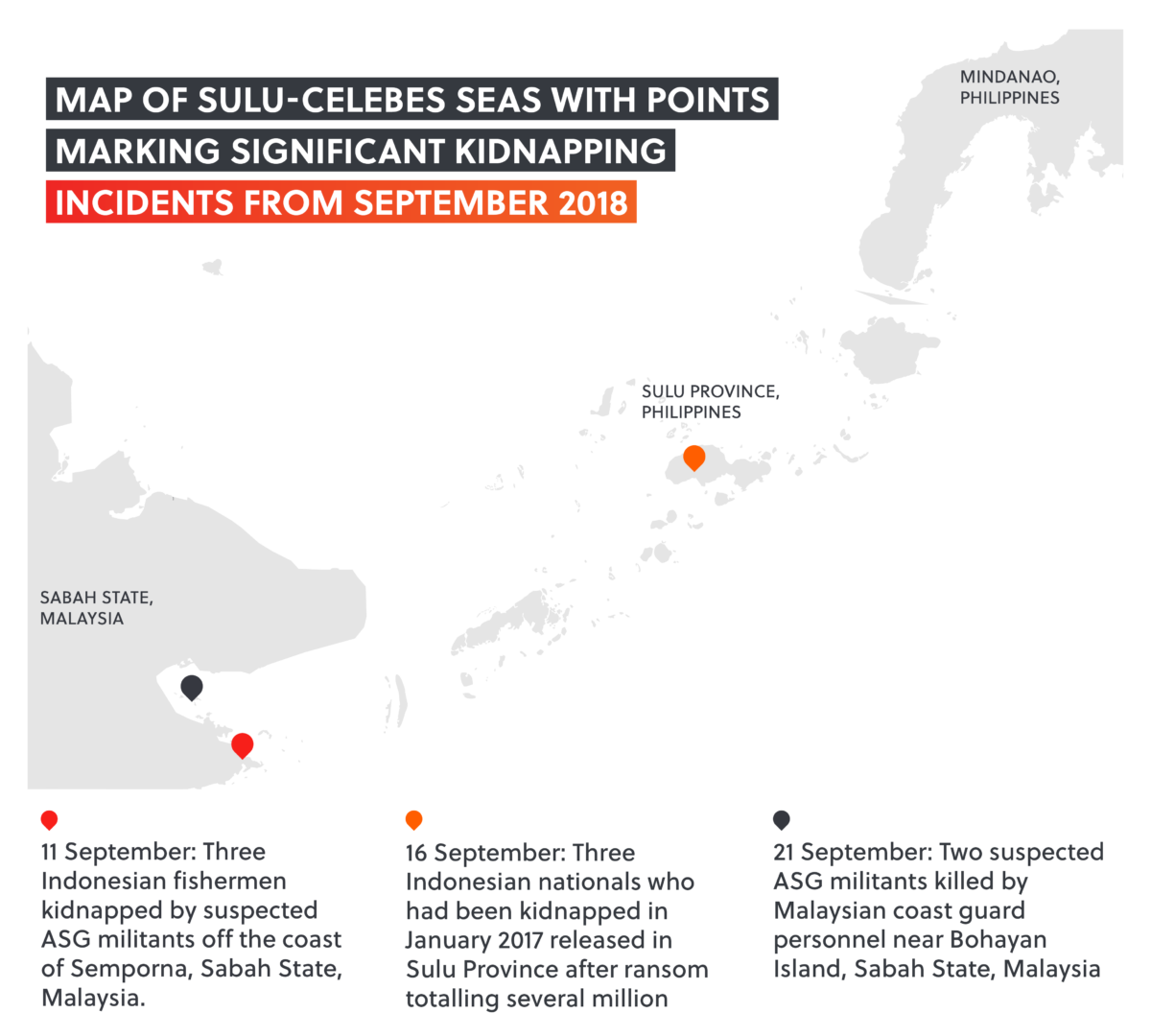Abu Sayyaf Returns? Maritime Kidnappings in the Sulu and Celebes seas in 2018
In September 2018, armed assailants abducted three Indonesian fishermen off the coast of Semporna, a town in Malaysia’s eastern Sabah State. The case has renewed concerns regarding the Abu Sayyaf Group (‘ASG’)’s involvement in maritime kidnappings in the Sulu and Celebes seas after an 18-month period of relative inactivity.
According to local media, the three victims were docked at a local jetty when the kidnapping took place. An eyewitness – a crewmember who avoided detection by the kidnappers – told local police that two armed assailants carrying assault rifles boarded the fishing vessel at around 01h00 local time before forcing the victims to disembark and board their speedboat. The perpetrators were overheard speaking Suluk, a dialect common in the southern Philippine province of Sulu, where ASG is primarily based. The dialect, combined with the tactics employed and weapons used, led investigators to conclude that ASG militants were likely responsible for the incident. Neither Philippine nor Malaysian authorities have confirmed whether ASG has issued a ransom demand for the three Indonesian victims.

However, the case has raised concerns that the group is resuming its maritime kidnapping activities as a means of generating revenue for its militant activities. For example, shortly after the above kidnapping incident, three other Indonesian hostages were released by ASG in Indanan, Sulu Province, in exchange for a hefty sum. These hostages had also been abducted off the Sabah coast in January 2017 and were released after a representative from the Moro National Liberation Front (‘MNLF’), an ethnic Moro Muslim separatist group which signed a peace agreement with the Philippine authorities in 1996, negotiated with ASG on behalf of the Philippine and Indonesian authorities. While authorities have not confirmed if a ransom was paid, Philippine media investigations indicate the Indonesian government paid several million USD to secure the release of all three hostages.
MARITIME KIDNAPPINGS BY ASG HAVE REMAINED A CONSISTENT THREAT TO FOREIGN TOURISTS, LOCAL FISHERMEN, AND SHIPPING INDUSTRY EMPLOYEES IN THE REGION FOR ALMOST TWO DECADES
THE RISE AND FALL OF MARITIME KIDNAPPINGS IN THE SULU AND CELEBES SEAS
Maritime kidnappings by ASG have remained a consistent threat to foreign tourists, local fishermen, and shipping industry employees in the region for almost two decades. However, the number of incidents off the coast of the southern Philippines and eastern Malaysia increased dramatically between 2016 and 2017. This figure jumped from zero in 2015, to 28 in 2016, and 10 in the first quarter of 2017. The majority of victims were employed in the fisheries and shipping industries, and several were foreign tourists.
The kidnappings have served both ASG’s financial and ideological objectives. The latter motivation became especially important after the group declared allegiance to the Middle East-based Islamic State (‘IS’) group in July 2014, and reiterated their support in 2016. ASG has historically alternated between being primarily engaged in militant and criminal activities, and its involvement in the latter delegitimised it in the eyes of many would-be foreign Islamist militants and fundraisers. However, through its affiliation with IS, the group improved its image among global Islamists by adopting similar propaganda tools, including the release of IS-inspired execution videos, such as the filmed beheading of a German hostage in February 2017. Following the adoption of these techniques, ASG reportedly received increased foreign donations and recruits, including fighters from the Middle East, Europe, and the Caucasus.
The 2016-2017 spike in maritime kidnappings prompted Philippine, Malaysian and Indonesian authorities to enhance maritime security cooperation in June 2017. These measures included enhanced information sharing and joint maritime patrols. After these measures were adopted, the number of maritime kidnappings declined dramatically, with no further incidents being reported until September 2018.

RISE AGAIN?
The September 2018 kidnappings have raised concerns about the continued effectiveness of these maritime security measures. Specifically, ASG’s apparent 18-month hiatus from maritime kidnappings has allegedly seen Philippine, Malaysian, and Indonesian maritime security personnel grow complacent, thereby allowing militants to slip by undetected. Further indicative of this trend, several instances of maritime piracy by either ASG or local criminal groups also occurred in the Sulu and Celebes seas in 2018 despite enhanced trilateral cooperation.
ASG also needs to recoup lost resources following failed militant operations in the southern Philippines, further increasing the threat of maritime kidnappings. Notably, ASG, along with the Maute Group, another group affiliated with IS, significantly depleted its human and financial resources during the failed May-November 2017 attempt to capture the city of Marawi, Lanao del Sur Province. The group’s most prominent commander, Isnilon Hapilon, was killed during the fighting, as were an estimated 975 additional ASG and Maute Group militants. Kidnapping for ransom has historically been the group’s primary means of generating revenue and, going forward, the group will likely view such tactics as an attractive means of recovering lost resources and funding future militant operations.
Both the apparent complacency of regional security forces, and ASG’s need to generate revenue in light of its failed activities in Marawi, are expected to contribute to an elevated threat of maritime kidnappings in the Sulu and Celebes seas. The most likely targets will include shipping industry and fisheries sector employees, as well as foreign tourists. Consequently, these industries are advised to closely monitor regional developments in order to ensure the continued safety of their personnel and maritime assets.